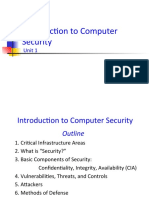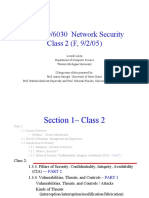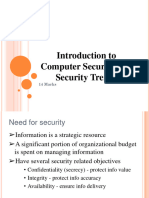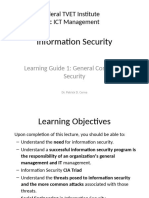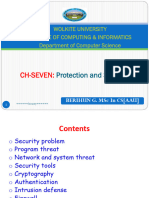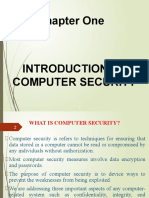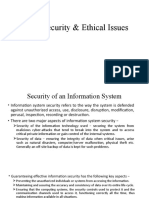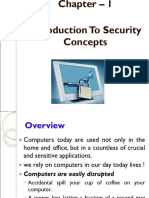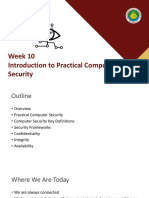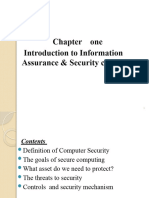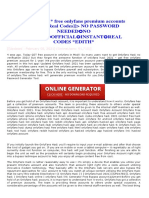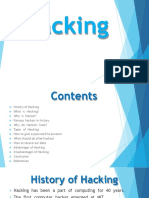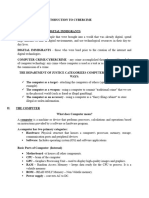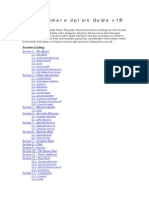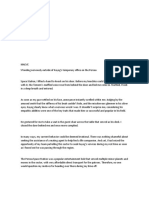1&2.
Introduction to Computer Security
Critical Infrastructure Areas
Include:
Telecommunications
Electrical power systems
Water supply systems
Gas and oil pipelines
Transportation
Government services
Emergency services
Banking and finance
…
2
What is a “Secure” Computer System?
To decide whether a computer system is “secure”, you
must first decide what “secure” means to you, then
identify the threats you care about.
You Will Never Own a Perfectly Secure System!
Threats - examples
Viruses, trojan horses, etc.
Denial of Service
Stolen Customer Data
Modified Databases
Identity Theft and other threats to personal privacy
Equipment Theft
Espionage in cyberspace
Hack-tivism
Cyberterrorism
…
3
Computer Security
Goals/CIA Triad
Learning Outcome
What are they?
How do they get violated? –
Scenario
Finding which goal is violated? –
Exercises
4
CIA Triad
6
Computer Security Goals
Definition
• Confidentiality (secrecy or privacy) – Ability of a
system to ensure that assets are viewed only by
authorized parties.
• An employee should not come to know the salary of his manager
• Integrity - Ability of a system to ensure that assets
are modified only by authorized parties or only in
authorized ways.
• An employee should not be able to modify his/her own salary
• Availability - Ability of a system to ensure that assets
are accessible to authorized parties at appropriate
times.
• Pay-checks should be printed on time as stipulated by law
7
3. Basic Components of Security:
Confidentiality, Integrity, Availability
CIA (CIA)
Confidentiality: Who is authorized to use C I
data? S
Integrity: Is data „good?”
Availability: Can access data whenever A
need it?
S = Secure
CIA or CIAAAN…
(other security components added to CIA)
Authentication
Authorization
Non-repudiation
…
8
Need to Balance
CIA
Example 1: C vs. I+A
Disconnect computer from Internet to increase
confidentiality
Availability suffers, integrity suffers due to lost
updates
Example 2: I vs. C+A
Have extensive data checks by different
people/systems to increase integrity
Confidentiality suffers as more people see data,
availability suffers due to locks on data under
verification)
9
Confidentiality
“Need to know” basis for data access
How do we know who needs what data?
Approach: access control specifies who can
access what
How do we know a user is the person she claims to
be?
Need her identity and need to verify this identity
Approach: identification and authentication
Analogously: “Need to access/use” basis for
physical assets
E.g., access to a computer room, use of a desktop
Confidentiality is:
difficult to ensure
10 easiest to assess in terms of success (binary in
Integrity
Integrity vs. Confidentiality
Concerned with unauthorized modification of assets
(= resources)
Confidentiality - concered with access to assets
Integrity is more difficult to measure than
confidentiality
Not binary – degrees of integrity
Context-dependent - means different things in
different contexts
Could mean any subset of these asset properties:
{ precision / accuracy / currency / consistency /
meaningfulness / usefulness / ...}
Types of integrity—an example
Quote from a politician
Preserve the quote (data integrity) but misattribute
11 (origin integrity)
Availability (1)
Not understood very well yet
„[F]ull implementation of availability is security’s
next challenge”
E.g. Full implemenation of availability for Internet
users (with ensuring security)
Complex
Context-dependent
Could mean any subset of these asset (data or
service) properties :
{ usefulness / sufficient capacity /
progressing at a proper pace /
completed in an acceptable period of
time / ...}
12 [Pfleeger & Pfleeger]
Availability (2)
We can say that an asset (resource) is
available if:
Timely request response
Fair allocation of resources (no starvation!)
Fault tolerant (no total breakdown)
Easy to use in the intended way
Provides controlled concurrency
(concurrency control, deadlock control, ...)
[Pfleeger &
Pfleeger]
13
4. Vulnerabilities, Threats, and
Controls
Understanding Vulnerabilities, Threats, and Controls
Vulnerability = a weakness in a security system
Threat = circumstances that have a potential to
cause harm
Controls = means and ways to block a threat, which
tries to exploit one or more vulnerabilities
Example - New Orleans disaster (Hurricane Katrina)
Q: What were city vulnerabilities, threats, and controls?
A: Vulnerabilities: location below water level, geographical
location in hurricane area, …
Threats: hurricane, dam damage, terrorist attack, …
Controls: dams and other civil infrastructures,
emergency response
plan, …
14
Attack (materialization of a vulnerability/threat
combination)
exploitation of one or more vulnerabilities by a threat; tries to
defeat controls
Attack may be:
Successful
resulting in a breach of security, a system
penetration, etc.
Unsuccessful
when controls block a threat trying to exploit a
vulnerability
15
Threat Spectrum/Types
Local threats
Recreational hackers
Institutional hackers
Shared threats
Organized crime
Industrial espionage
Terrorism
National security threats
National intelligence
Info warriors
16
Kinds of Threats
Kinds of threats:
Interception
an unauthorized party (human or not) gains
access to an asset
Interruption
an asset becomes lost, unavailable, or unusable
Modification
an unauthorized party changes the state of an
asset
Fabrication
an unauthorized party counterfeits an asset
Examples?
17
Levels of Vulnerabilities / Threats
(reversed order to illustrate interdependencies)
D) for other assets (resources)
including. people using data, s/w, h/w
C) for data
„on top” of s/w, since used by s/w
B) for software
„on top” of h/w, since run on h/w
A) for hardware
[Pfleeger & Pfleeger]
18
A) Hardware Level of Vulnerabilities /
Threats
Add / remove a h/w device
Ex: Snooping, wiretapping
Snoop = to look around a place secretly in order to discover
things about it or the people connected with it.
Ex: Modification, alteration of a system
Physical attacks on h/w => need physical security:
locks and guards
Accidental (dropped PC box) or voluntary (bombing
a computer room)
Theft / destruction
Damage the machine (spilled coffe, mice, real
bugs)
Steal the machine
„Machinicide:” Axe / hammer the machine
...
19
Example of Snooping:
Wardriving / Warwalking, Warchalking,
Wardriving/warwalking -- driving/walking
around with a wireless-enabled notebook
looking for unsecured wireless LANs
Warchalking -- using chalk markings to
show the presence and vulnerabilities of
wireless networks nearby
E.g., a circled "W” -- indicates a WLAN
protected by Wired Equivalent Privacy
(WEP) encryption
20
B) Software Level of Vulnerabilities /
Threats
Software Deletion
Easy to delete needed software by mistake
To prevent this: use configuration
management software
Software Modification
Trojan Horses, , Viruses, Logic Bombs,
Trapdoors, Information Leaks (via covert
channels), ...
Software Theft
Unauthorized copying
via P2P, etc.
21
Types of Malicious Code
Bacterium - A specialized form of virus which does not attach to a specific file. Usage obscure.
Logic bomb - Malicious [program] logic that activates when specified conditions are met.
Usually intended to cause denial of service or otherwise damage system resources.
Trapdoor - A hidden computer flaw known to an intruder, or a hidden computer mechanism
(usually software) installed by an intruder, who can activate the trap door to gain access to the
computer without being blocked by security services or mechanisms.
Trojan horse - A computer program that appears to have a useful function, but also has a
hidden and potentially malicious function that evades security mechanisms, sometimes by
exploiting legitimate authorizations of a system entity that invokes the program.
Virus - A hidden, self-replicating section of computer software, usually malicious logic, that
propagates by infecting (i.e., inserting a copy of itself into and becoming part of) another
program. A virus cannot run by itself; it requires that its host program be run to make the virus
active.
Worm - A computer program that can run independently, can propagate a complete working
version of itself onto other hosts on a network, and may consume computer resources
destructively.
More types of malicious code exist… [cf. http://www.ietf.org/rfc/rfc2828.txt]
22
C) Data Level of Vulnerabilities /
Threats
How valuable is your data?
Credit card info vs. your home phone number
Source code
Visible data vs. context
„2345” -> Phone extension or a part of SSN?
Adequate protection
Cryptography
Good if intractable for a long time
Threat of Identity Theft
Cf. Federal Trade Commission: http://www.consumer.gov/idtheft/ \
23
Identity Theft
Cases in 2003:
Credit card skimmers plus drivers license, Florida
Faked social security and INS cards $150-$250
Used 24 aliases – used false id to secure credit
cards, open mail boxes and bank accounts, cash
fraudulently obtained federal income tax refund
checks, and launder the proceeds
Bank employee indicted for stealing depositors'
information to apply over the Internet for loans
$7M loss, Florida: Stole 12,000 cards from
restaurants via computer networks and social
engineering
Federal Trade Commission:
http://www.consumer.gov/idtheft/
[Barbara Edicott-Popovsky and Deborah Frincke, CSSE592/492, U. Washington]
24
Types of Attacks on Data CIA
Disclosure
Attack on data confidentiality
Unauthorized modification / deception
E.g., providing wrong data (attack on data integrity)
Disruption
DoS (attack on data availability)
Usurpation
Unauthorized use of services (attack on data confidentiality,
integrity or availability)
25
Ways of Attacking Data CIA
Examples of Attacks on Data Confidentiality
Tapping / snooping
Examples of Attacks on Data Integrity
Modification: salami attack -> little bits add up
E.g/ „shave off” the fractions of cents after interest calculations
Fabrication: replay data -> send the same thing again
E.g., a computer criminal replays a salary deposit to his
account
Examples of Attacks on Data Availability
Delay vs. „full” DoS
Examples of Repudiation Attacks on Data:
Data origin repudiation: „I never sent it”
Repudiation = refusal to acknowledge or pay a debt or honor a
contract (especially by public authorities).
[http://www.onelook.com]
Data receipt repudiation: „I never got it”
26
D) Vulnerab./Threats at Other
Exposure
Points
Network vulnerabilities / threats
Networks multiply vulnerabilties and threats, due to:
their complexity => easier to make
design/implem./usage mistakes
„bringing close” physically distant attackers
Esp. wireless (sub)networks
Access vulnerabilities / threats
Stealing cycles, bandwidth
Malicious physical access
Denial of access to legitimate users
People vulnerabilities / threats
Crucial weak points in security
too often, the weakest links in a security chain
Honest insiders subjected to skillful social engineering
Disgruntled employees
27
5. Attackers
Attackers use MOM term.
Method
Skill, knowledge, tools, etc. with which to pull off an
attack
Opportunity
Time and access to accomplish an attack
Motive
Reason to perform an attack
28
Types of Attackers
Types of Attackers - Classification 1
Amateurs
Opportunistic attackers (use a password they found)
Script kiddies
Hackers - nonmalicious
In broad use beyond security community: also malicious
Crackers – malicious
Career criminals
State-supported spies and information warriors
Types of Attackers - Classification 2 (cf. before)
Recreational hackers / Institutional hackers
Organized criminals / Industrial spies / Terrorists
National intelligence gatherers / Info warriors
29
New Internet
Attacks
High Packet Forging & Spoofing
Stealth Diagnotics
DDOS Sophistication of
Hacker Tools
Sweepers Sniffers
Hijacking Sessions
Back Doors
Self-Replicating Code Technical Knowledge
Required
Password Cracking
Password Guessing
Time
30
6. Reacting to an Exploit
Exploit = successful attack
Report to the vendor first?
Report it to the public?
What will be public relations effects if you do/do not?
Etc.
31
“To Report or Not To Report:”
Tension between Personal
Privacy and Public
Responsibility
An info tech company will typically lose
between ten and one hundred times more
money from shaken consumer confidence
than the hack attack itself represents if they
decide to prosecute the case.
32
Computer Forensics
Against Computer Crime
Technology
Law Enforcement
Individual and Societal Rights
Judiciary
…
33
7. Methods of Defense
Five basic approaches to defense of
computing systems
Prevent attack
Block attack / Close vulnerability
Deter attack
Make attack harder (can’t make it
impossible )
Deflect attack
Make another target more attractive than
this target
Detect attack TOCTOCont.
During or after
34
Recover from attack
Controls
Castle in Middle Ages Computers Today
Location with natural Encryption
obstacles Software controls
Surrounding moat Hardware controls
Drawbridge Policies and
Heavy walls procedures
Arrow slits
Physical controls
Crenellations
Strong gate
Tower
Guards / passwords
35
Medieval castles
location (steep hill, island, etc.)
moat / drawbridge / walls / gate / guards /passwords
another wall / gate / guards /passwords
yet another wall / gate / guards /passwords
tower / ladders up
Multiple controls in computing systems can include:
system perimeter – defines „inside/outside”
preemption – attacker scared away
deterrence – attacker could not overcome
defenses
faux environment (e.g. honeypot, sandbox) –
attack deflected towards a worthless target (but
the attacker doesn’t know about it!)
Note layered defense /
36
multilevel defense / defense in depth (ideal!)
A.1) Controls: Encryption
Primary controls!
Cleartext scambled into ciphertext (enciphered text)
Protects CIA:
confidentiality – by „masking” data
integrity – by preventing data updates
e.g., checksums included
availability – by using encryption-based protocols
e.g., protocols ensure availablity of resources for
different users
37
A.2) Controls: Software Controls
Secondary controls – second only to encryption
Software/program controls include:
OS and network controls
E.g. OS: sandbox / virtual machine
Logs/firewalls, OS/net virus scans, recorders
independent control programs (whole programs)
E.g. password checker, virus scanner, IDS (intrusion
detection system)
internal program controls (part of a program)
E.g. read/write controls in DBMSs
development controls
E.g. quality standards followed by developers
incl. testing
38
Considerations for Software Controls:
Impact on user’s interface and workflow
E.g. Asking for a password too often?
39
A.3) Controls: Hardware
Controls
Hardware devices to provide higher degree of
security
Locks and cables (for notebooks)
Smart cards, dongles, hadware keys, ...
...
40
A.4) Controls: Policies and
Procedures
Policy vs. Procedure
Policy: What is/what is not allowed
Procedure: How you enforce policy
Advantages of policy/procedure controls:
Can replace hardware/software controls
Can be least expensive
Be careful to consider all costs
E.g. help desk costs often ignored for for passwords (=> look
cheap but migh be expensive)
41
Policy - must consider:
Alignment with users’ legal and ethical standards
Probability of use (e.g. due to inconvenience)
Inconvenient: 200 character password,
change password every week
(Can be) good: biometrics replacing passwords
Periodic reviews
As people and systems, as well as their goals, change
42
A.5) Controls: Physical
Controls
Walls, locks
Guards, security cameras
Backup copies and archives
Cables an locks (e.g., for notebooks)
Natural and man-made disaster
protection
Fire, flood, and earthquake protection
Accident and terrorism protection
...
43
8. Principles of Computer Security
Principle of Easiest Penetration
An intruder must be expected to use any
available means of penetration.
The penetration may not necessarily be by the most
obvious means, nor is it necessarily the one against
which the most solid defense has been installed.
Principle of Adequate Protection
Computer items must be protected to a
degree consistent with their value and only
until they lose their value.
44
Principle of Effectiveness
Controls must be used—and used properly—
to be effective.
They must be efficient, easy to use, and
appropriate.
Principle of Weakest Link
Security can be no stronger than its weakest
link.
Whether it is the power supply that powers the
firewall or the operating system under the security
45
application or the human, who plans, implements,
End of Module 1-2:
Introduction



